
Apples are a common ingredient for sweet pies, but there is one type of apple that many bakers avoid using. In this blog post, we’ll explore the use of this controversial ingredient while baking. We will also use a new tutorial model to go over how to model the heat transfer process that occurs in a pie as it is being baked in a domestic oven.
To Bake or Not to Bake
Apple to Apples
There are an endless amount of apple pie recipes available online, all featuring their own take on the popular dessert. However, most sources agree that there are certain apples that are more preferable to use when making a pie than others, including, but not limited to, Granny Smith, Golden Delicious, Honeycrisp, and Braeburn apples. The balance of sweetness and tartness of these apples is what make them ideal for baking.
Now, if you want to avoid making a subpar-tasting apple pie, many chefs suggest steering clear of Red Delicious apples because they easily fall apart and lose flavor when subjected to high temperatures. In a blog post on Serious Eats, an apple pie made with Red Delicious apples was ranked a 1 out of 10 — making it the lowest ranked apple pie on the list.
Learning of the notoriety of the Red Delicious in the baking world made me curious to see how it performs for myself. In the rest of this section, we will compare an apple pie made with Granny Smith apples and one made with Red Delicious apples. Both pies will be made using the same recipe, ingredients, and baking procedure. (If you want to skip to the section related to the modeling of a pie in an oven, click here.)
The Recipe
Apples pies call for two necessary components: crust and filling. To make the crust I used a simple recipe that required flour, butter, salt, sugar, and water. For the filling, I followed this recipe, which called for the following ingredients:
- 6 medium-sized apples
- 150 grams (3/4 cup) sugar
- 2 tablespoons all-purpose flour
- 3/4 teaspoon ground cinnamon
- 1/4 teaspoon salt
- 1/8 teaspoon ground nutmeg
- 1 tablespoon lemon juice
To assemble the pie made with Red Delicious apples, I placed one pie crust in an oval-shaped glass baking dish. Then, I combined all of the filling’s ingredients in a large bowl. Next, I added the filling into the crust-lined baking dish. Once all of the filling was added, I placed a second pie crust on top of the pie and pressed both crusts’ edges together. Finally, a few slits were added to the top layer of crust and the entire pie was placed into an oven at ~220°C. It was left to bake for 45 minutes.
I then repeated this same process for the pie made with Granny Smith apples. The only difference between the two pies is the shape of the dishes that they were baked in.
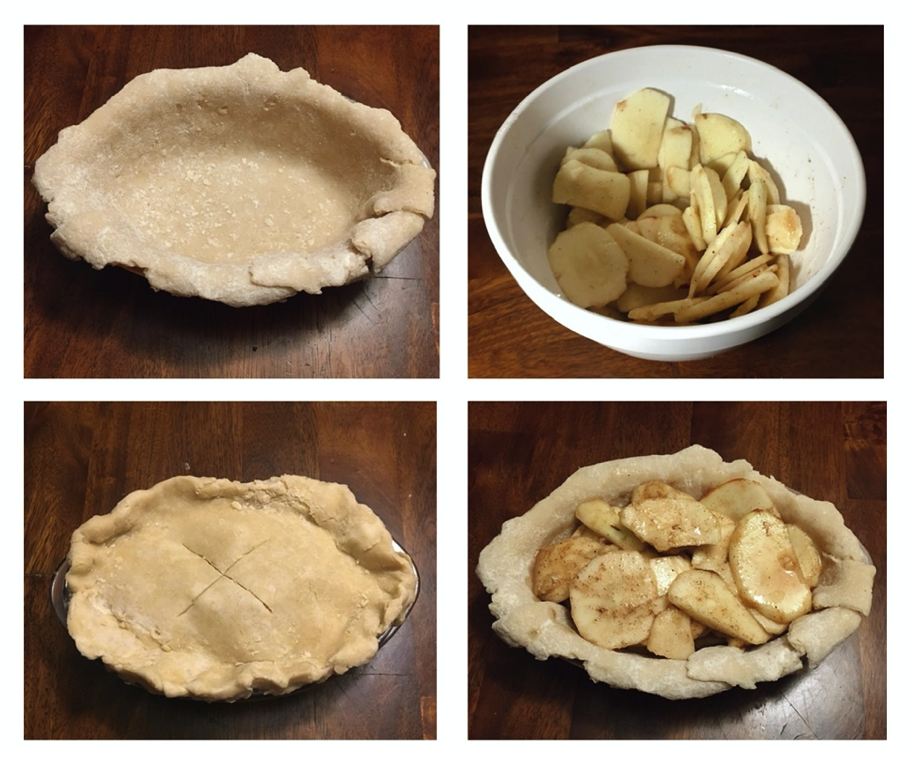
Different stages of the apple pie baking process, using Red Delicious apples (clockwise from the start to ready-to-bake phase).
Red Delicious vs. Granny Smith
Do pies made with Red Delicious apples taste bad? Are Granny Smith apples the gold standard baking apple?
To me, the apple pie made with Red Delicious apples was more heavy, but, as the critics suggested, it lacked flavor. It tasted more watery and less cooked through compared to the pie made with Granny Smith apples. It also had a slightly gritty texture.
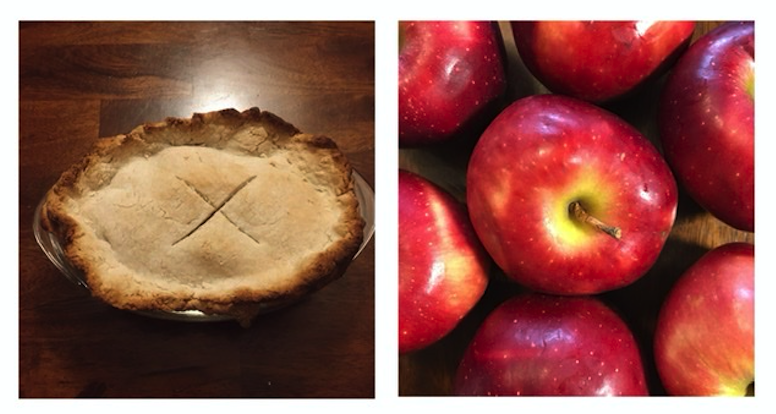
An apple pie made with Red Delicious apples (left) and several Red Delicious apples (right).
The Granny Smith apple pie embodied the classic apple pie flavor: tart, but not too tart; sweet, but not too sweet. However, it had a strong aftertaste of lemon.
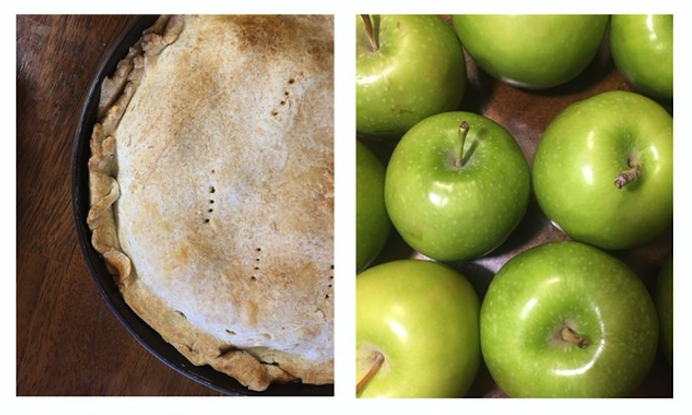
An apple pie made with Granny Smith apples (left) and several Granny Smith apples (right).
Both pies had their own pros and cons, but, like many others, I also recommend using Granny Smith apples when baking. However, if your mission is to get rid of those leftover Red Delicious apples from apple picking season, I think it’s worth salvaging them in a pie!
So, now that we know what ingredients taste good in a pie, let’s go over the heat transfer process that occurs when they are being baked in an oven…
Simulating Heat Transfer in a Domestic Oven when Baking a Pie
Whichever apples you choose for your pie, having steady heat transfer is essential to the baking process.
Inside an oven, heat is transmitted through three heat transfer processes:
- Convection: The fan at the rear of the oven blows hot air inside the oven.
- Conduction: This is how heat is transmitted from the edges to the middle of the pie. It is also the process by which heat is exchanged between the air and the pie at their interface.
- Radiation: The hot resistance radiates toward the oven walls and toward the pie.
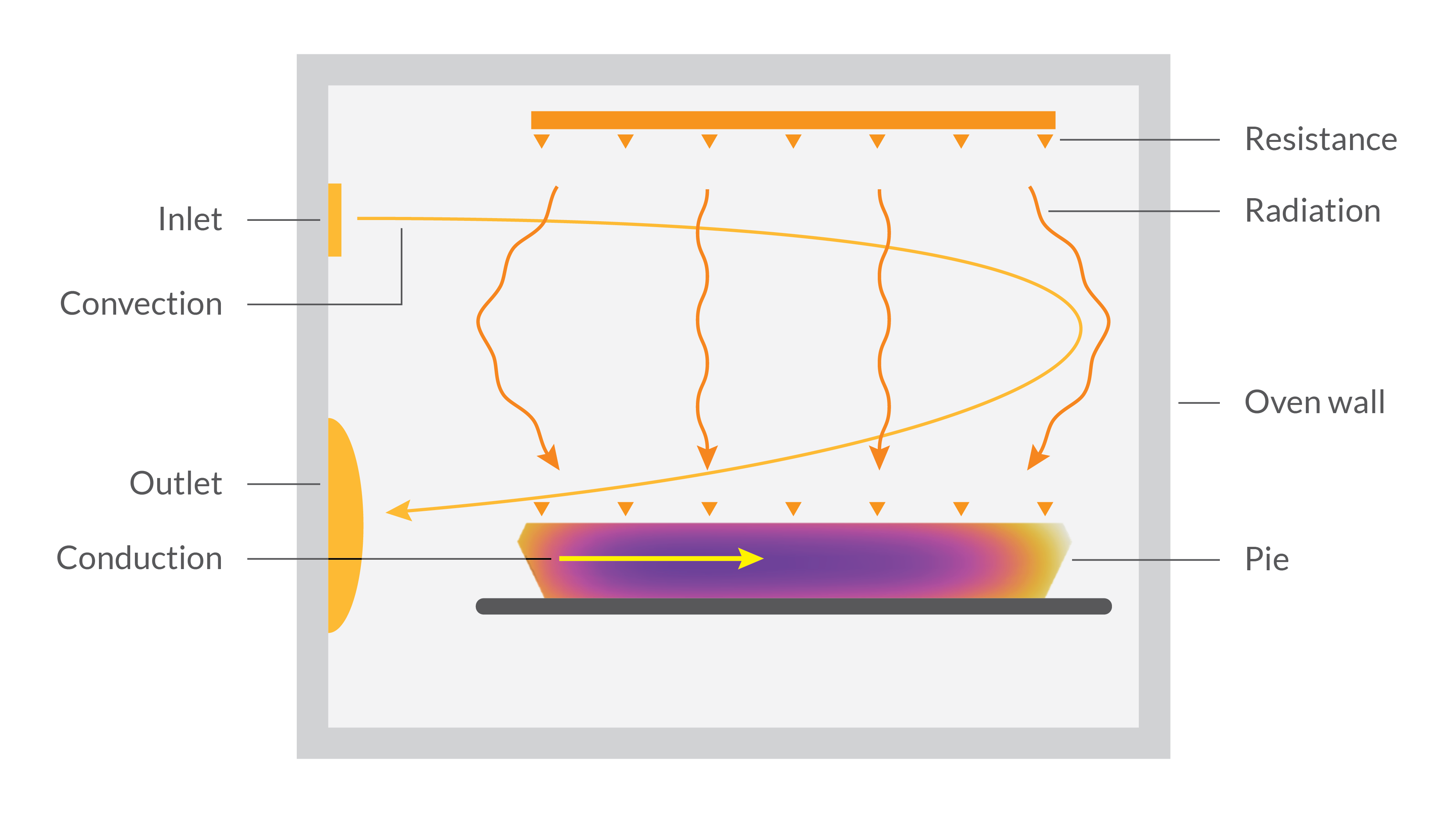
Heat transfer process in an oven.
Modern ovens have several heating modes to allow slow cooking, grill, lower, or upper heating. The mode you select determines the activation of the upper resistance, rear fan, and rear resistance.
Consider an oven set to fan-grill mode so that the upper resistance (1000 W), rear resistance (1500 W), and rear fan are activated. The target temperature of the oven is set to 220°C. How uniform is the temperature distribution in the pie? How close is it to the target temperature? How much energy did it take to cook it? Let’s use simulation to find the answers.
Intuitive Modeling
A first look at the application suggests that it is necessary to consider the fluid flow around the pie, the heat transfer in both the air and the pie, and the surface-to-surface radiation to get a complete picture. In the COMSOL Multiphysics® software, we can use the
After 45 minutes in the oven, the pie temperature is uneven, varying from 140°C in the middle to 210°C at the edge. The average temperature is about 160°C.
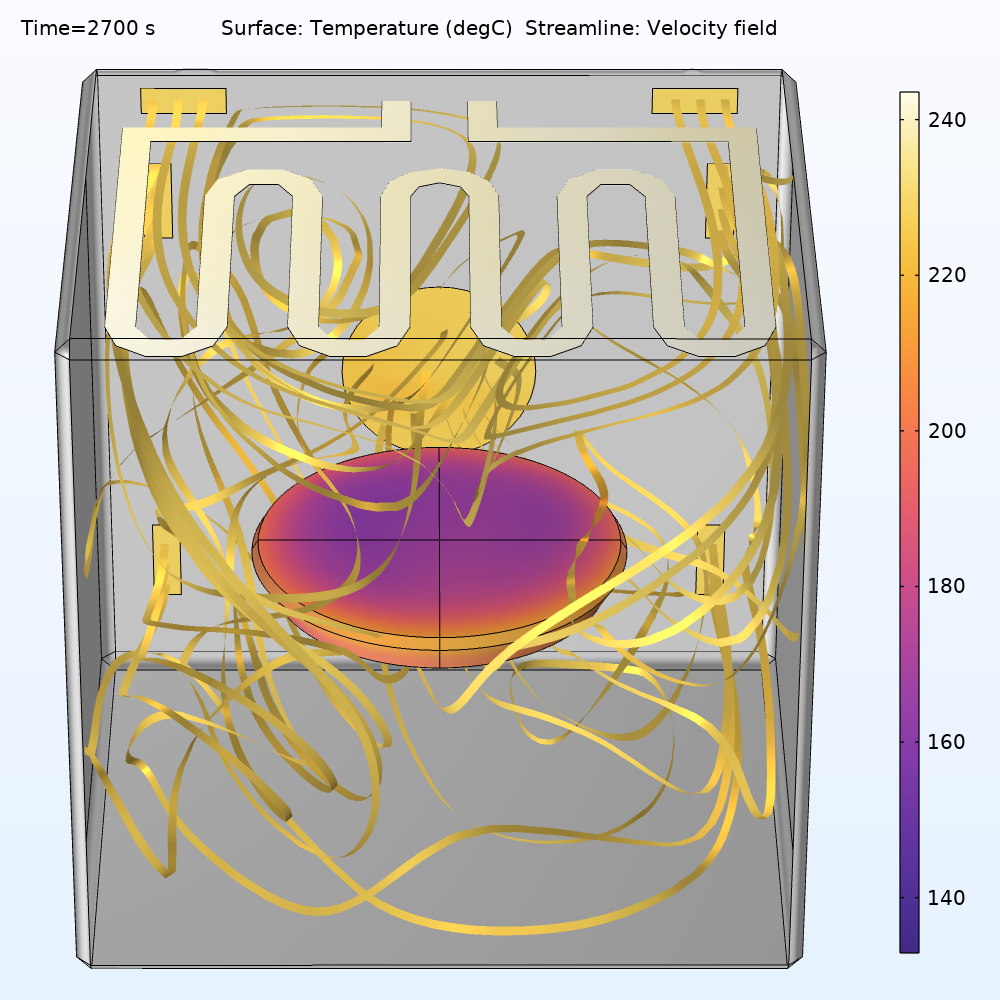
Temperature and velocity streamlines (colored by temperature) inside a domestic oven.
The oven has been in use for one hour, and consumed 0.26 kWh to keep the air to a temperature of 220°C.
Well, great job! We have answered the initial questions without going too deep into the modeling process. But what if we go into more detail? Was it too simple to be accurate?
Advanced Modeling
Knowledge of simulation and of the physics involved in the application you want to model is essential for getting accurate and fast results. For what we want to evaluate in this application, the first modeling process is not missing any physics, but is actually too broad. In such cases, natural convection can be neglected, as forced convection is predominant. This implies that the fluid flow and the heat transfer are weakly coupled. It also means that the air can be considered incompressible. These two points are simplifications of the model, and will result in a decrease of the computation time. Indeed, the computation is 4 times faster than in the first modeling example.
And the results? They’re almost identical!
Average temperature in the pie (left) and total energy consumed by the oven (right) over time.
Try It Yourself
Baking is a common application of heat transfer physics, which is why it’s a perfect example for illustrating how you can use COMSOL Multiphysics to model fluid flow and heat transfer coupling. Here, we used simulation to showcase the heating process of a pie in a domestic oven, considering conduction, convection, and radiation.
Want to try out the related model file? Click the button below to be taken to the Application Gallery entry.
Note: Using the tutorial model, you can update the oven’s temperature and the duration of time that it bakes a meal, such as a pie, to best match your modeling needs. Here, we made it run at 220°C for 45 minutes to match the average baking procedure of an apple pie.
Further Reading
Want to learn more about the use of simulation for food applications? Explore these related blog posts:


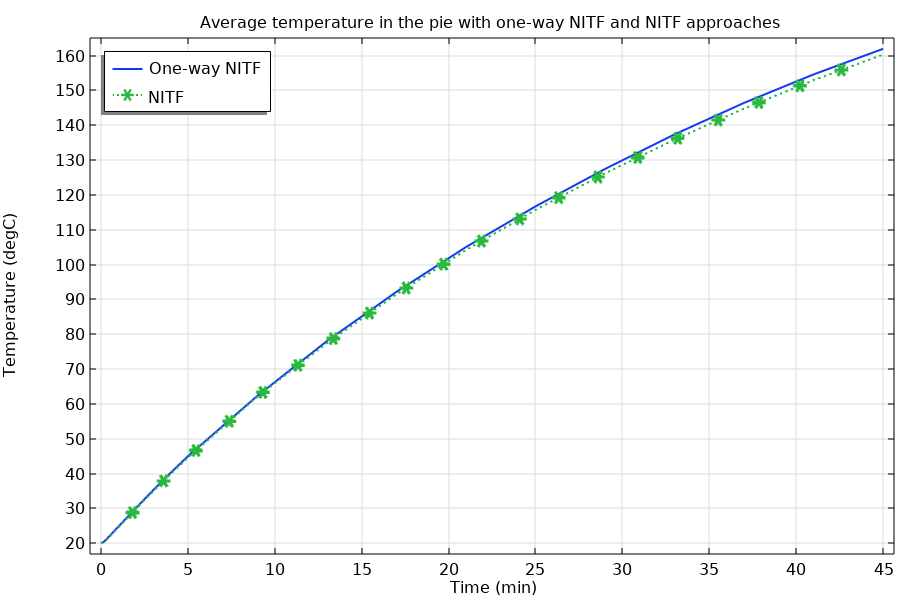
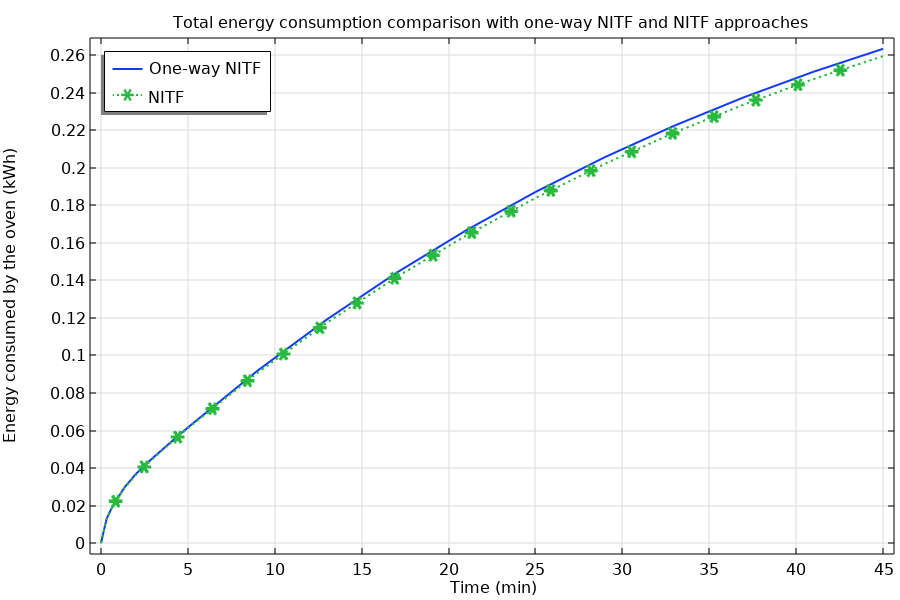


Comments (6)
John Neumann
March 25, 2022It would be interesting to impose a 210 degC temperature boundary condition (or perhaps a linear ramp up in temperature from room temperature to 210 C) at the surface of the pie, to further reduce the amount of computation (just model the pie, not the surroundings), to see how important the air flow is with respect to the temperature distribution in the pie.
Robert Gustavsson
March 28, 2022Great idea, I agree 🙂
Alireza Naeini
March 28, 2022Hello,
The model file need the CAD import module to work.
Could you please change the file to the format that does not need this module.
Thanks,
Anthony Paumier
March 29, 2022 COMSOL EmployeeHello,
Thank you for reading this blog. The Design module is used to create the geometry of the model, specifically to add constraints, which is particularly handy to parameterize the pie for example. Without the Design module, the geometry will not be generated properly.
Anthony
Kevin Goddard
May 23, 2022There seems to be an inconsistency between the modelling assumptions and the cooking instructions. Presumably, the slits in the lid are intended to release steam, but the model does not allow for boiling or evaporation.
Anthony Paumier
May 23, 2022 COMSOL EmployeeHello,
Thank you for your comment. We made the choice to focus the study on convective, conductive and radiative heat transfer, and have not taken into account the contribution of evaporation. You are right, the slits allow steam to escape from the pie, and prevent critical expansion that would cause structural damage of the pie!
This contribution could indeed be added in a more advanced model as it also has an effect on the model’s thermics.
Anthony